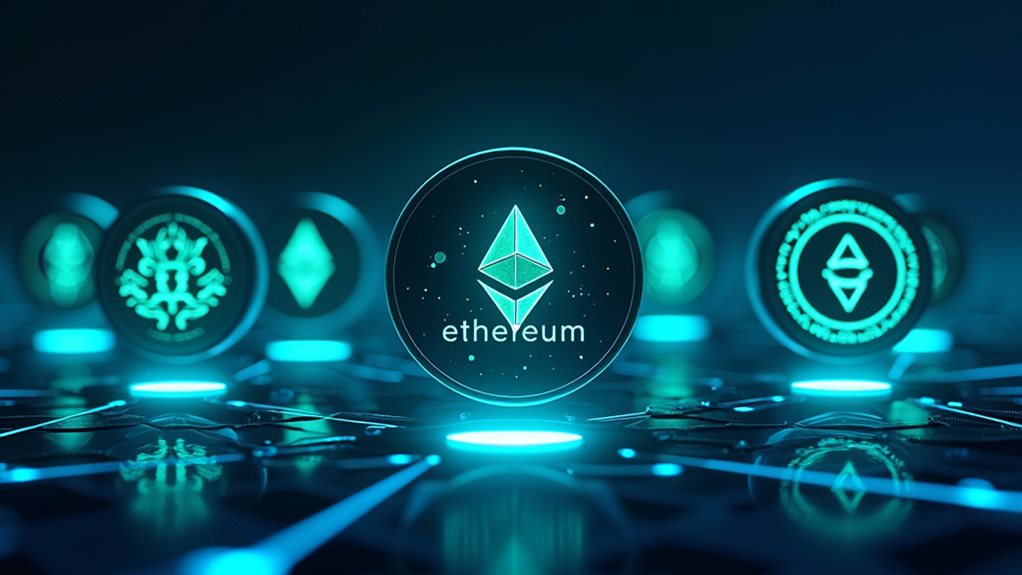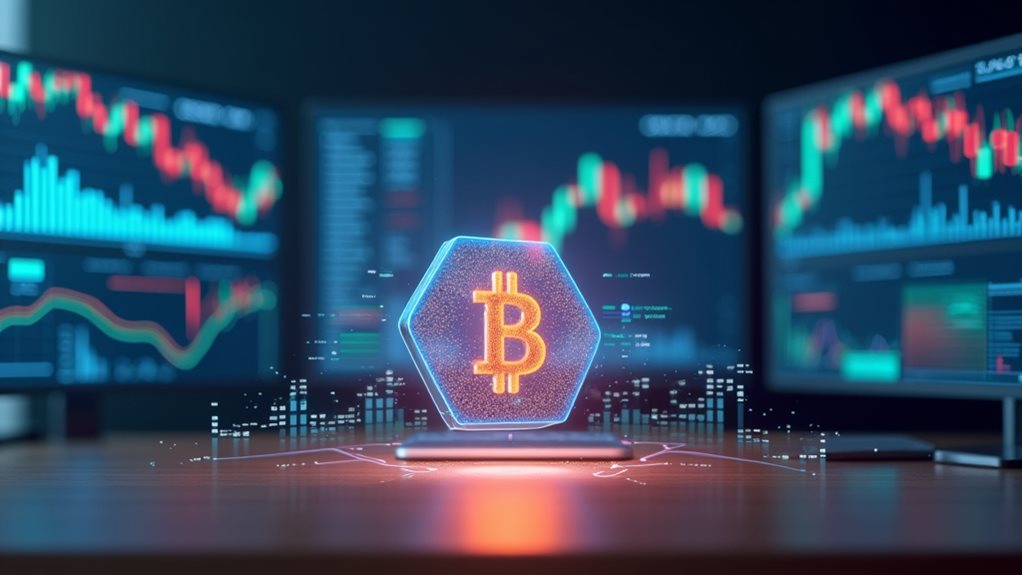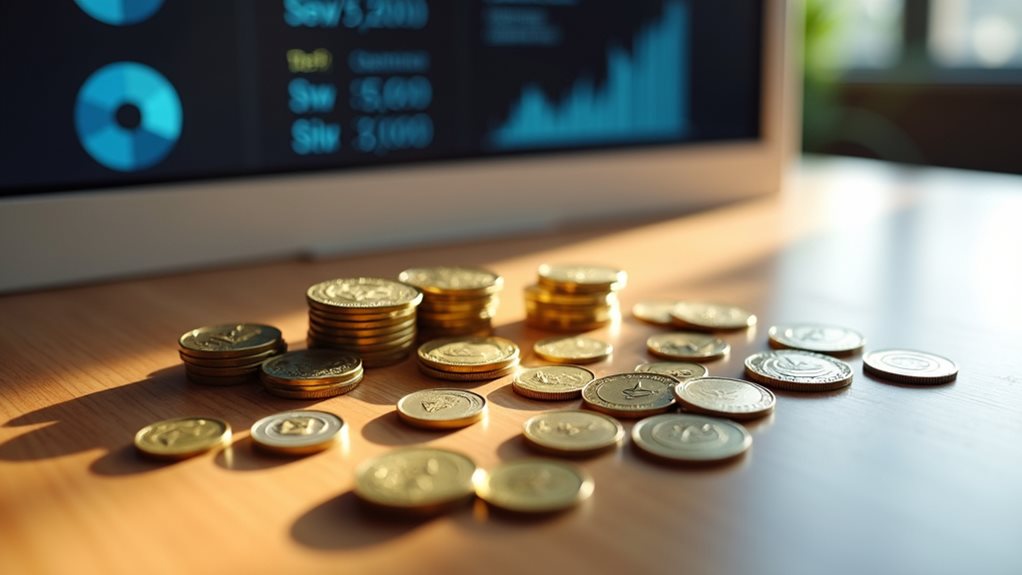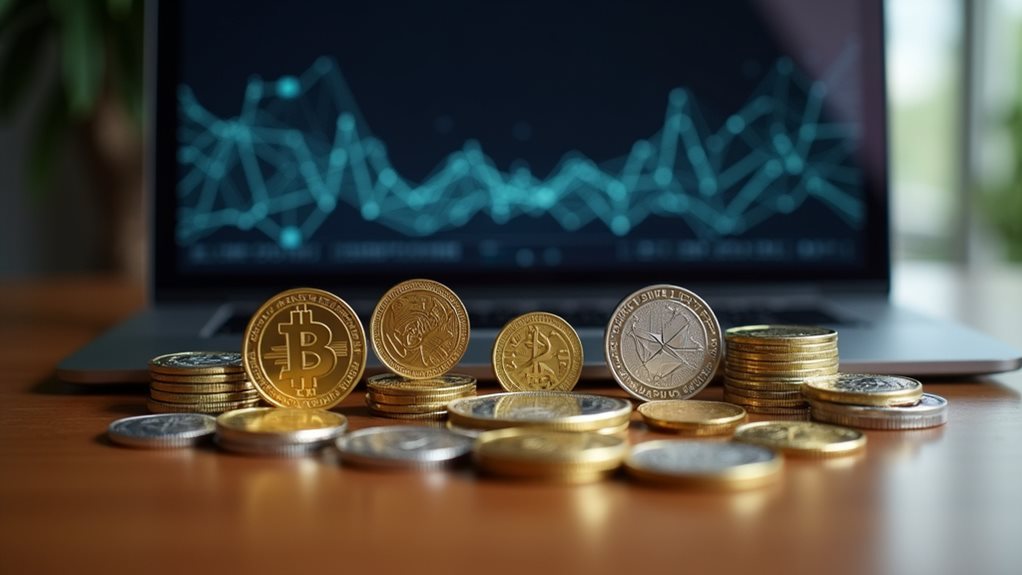Altcoins are any cryptocurrencies that aren’t Bitcoin. They range from payment solutions like Litecoin to smart contract platforms like Ethereum. When choosing investments, look at market cap, developer activity, token utility, and supply distribution. Don’t get suckered by hype alone. A solid project needs transparent teams, working products, and clear use cases. Diversification is key—spread your bets across large, mid, and small-cap tokens. The crypto environment rewards those who do their homework.
Understanding Altcoins: Beyond Bitcoin’s Shadow

Countless altcoins now populate the crypto ecosystem, each fighting to emerge from Bitcoin’s massive shadow. These digital currencies aren’t just Bitcoin copycats. Far from it. They’re laboratories of innovation.
While Bitcoin trudges along with its dinosaur-like Proof-of-Work system, altcoins enable smart contracts and decentralized applications. Altcoins offer diverse applications ranging from DeFi to healthcare and supply chain management. Pretty useful, right?
Bitcoin clings to outdated tech while nimble altcoins revolutionize the space with genuinely useful innovations.
Solana processes transactions at lightning speed – up to 50 times faster than Bitcoin. No joke. Smart contract audits help protect these platforms from potential vulnerabilities.
Market trends show increasing specialization. Some altcoins focus on privacy (Monero), others on gaming or DeFi. Each carving out its own niche. The days of one-size-fits-all crypto are dead.
Remember when Bitcoin was 80% of crypto’s market cap? Those days are gone. Ethereum and others keep gaining ground. Bitcoin’s market dominance currently sits at 59.5% market share, with Ethereum holding the second position.
Bitcoin maximalists hate this fact, but altcoins aren’t going anywhere.
The Diverse Landscape of Altcoin Categories

While Bitcoin still dominates headlines, the altcoin universe has exploded into distinct categories that serve wildly different purposes.
No two coins are created equal.
You’ve got payment altcoins like Litecoin that want to be digital cash.
Smart contract platforms—Ethereum, Solana—run the show for developers.
DeFi tokens power financial revolutions, while stablecoins keep things, well, stable. Boring but necessary.
Governance tokens let you vote on blockchain futures. Not exactly thrilling, but powerful.
Then there’s the wilder side: privacy coins for the paranoid, NFT tokens for digital art collectors, and meme coins for… gambling, let’s be honest.
Utility tokens serve actual purposes within ecosystems, while financial derivatives bring Wall Street complexity to crypto.
The crypto zoo is vast. Choose your animals wisely.
Infrastructure cryptocurrencies like Avalanche are designed to overcome scaling issues that plague older blockchain networks, enabling faster transactions with lower fees.
With over 22,000 cryptocurrencies currently in existence, the altcoin market offers unprecedented variety for investors willing to look beyond Bitcoin.
For maximum security, many investors store their diverse altcoin portfolios in cold storage wallets to protect against online threats.
Key Metrics for Evaluating Altcoin Investment Potential

How exactly do you separate the next Ethereum from the next crypto catastrophe? It’s not about hype or Twitter followers. It’s about hard metrics. Cold, unforgiving numbers don’t lie.
Numbers cut through crypto hype, revealing the stark difference between innovation and impending disaster.
When evaluating altcoins, focus on these critical indicators:
1. Market cap analysis – Compare it to active users. If the ratio is sky-high, you’re looking at speculation, not value.
2. Token velocity – High transaction volume relative to network value often signals trading frenzy, not utility.
3. Development activity – Ghost towns on GitHub? Run away. Fast.
4. Supply distribution – When 80% sits with three wallets, you’re not an investor. You’re prey.
Remember: impressive partnerships mean nothing without on-chain activity.
Teams with flashy LinkedIn profiles sometimes deliver zero code commits. Crypto’s brutal that way. Modern altcoins like Chia and IOTA are focusing on energy efficiency to ensure long-term sustainability.
5. Price-to-earnings ratio – Calculate this by dividing market cap by annualized protocol revenue to determine if the token is fairly valued.
6. Security track record – Examine how long the protocol has operated without experiencing hacks, as most leading DeFi applications have maintained zero security exploits since launch.
Technical Fundamentals: What Makes a Strong Altcoin Project

Beyond metrics and numbers lies the architecture that makes or breaks an altcoin’s future.
First things first: who’s building it? A verifiable development team with proven experience isn’t just nice—it’s non-negotiable. Project transparency matters too. If founders are hiding, run. Implementing secure key management can prevent permanent loss of investments.
Token utility separates the winners from the wannabes. What does the token actually do? Governance rights? Transaction fees? Staking rewards? No utility, no long-term value. Simple as that.
Market integration can’t be faked. Look for projects that play well with others—DeFi ecosystems, NFT marketplaces, other blockchains. Isolation equals death in crypto. Projects with real-world applications typically carry lower investment risk compared to purely conceptual altcoins. Thorough analysis of these fundamentals helps identify altcoins with genuine long-term potential.
And remember: fancy whitepapers are cheap. Working products aren’t. Code speaks louder than promises. Always has, always will.
Risk Management Strategies for Altcoin Investors

Since altcoins can make you rich overnight or broke by morning, your survival depends on rock-solid risk management. The crypto market doesn’t care about your feelings—it will happily take your money if you’re sloppy.
Four critical strategies to keep your portfolio alive:
- Diversify like your financial life depends on it – spread investments across large caps, mid caps, and stablecoins.
- Use stop-losses religiously – set them below support levels to avoid getting rekt while you sleep.
- Size positions according to your risk appetite – never risk more than 1-3% on a single trade.
- Dollar-cost average – because nobody (seriously, nobody) can time this market consistently.
Your investment horizon matters too. Long-term holders can weather volatility that would destroy day traders. With yield-bearing stablecoin alternatives emerging in the market, investors have more options for managing risk during turbulent periods. Monitoring market sentiment regularly can help you anticipate potential shifts in altcoin performance. Implementing hardware wallets for long-term holdings provides essential protection against the billions lost yearly to crypto theft.
Choose your battlefield wisely.
Navigating Market Cycles in the Altcoin Ecosystem

While the crypto world once operated on predictable cycles, the altcoin environment of 2025 has completely rewritten the rulebook.
Forget the days when altcoins reliably pumped 80-90% during bull markets—we’re looking at a measly 58% now.
Why? Institutions have muscled in, pushing retail traders aside.
Market sentiment isn’t driven by Reddit threads anymore. It’s boardroom decisions and ETF inflows calling the shots.
The big money follows liquidity trends, not hype, concentrating in Ethereum, Solana, and projects with actual use cases. Imagine that.
Cross-chain capital migration is the new normal. Money flows where it’s treated best—cheaper transactions, faster networks.
Analysts recommend getting in early as strategic timing can be the difference between moderate gains and life-changing returns in the upcoming bull market.
Grayscale’s ETF filing could revolutionize how institutional investors access the altcoin market.
The current market conditions mirror the 2020 DeFi boom, driven by technological innovations and network congestion issues.
The days of a rising tide lifting all altcoin boats? Dead. The game’s changed. Adapt or get rekt.
Building a Balanced Altcoin Portfolio for Long-Term Growth

Constructing a balanced altcoin portfolio isn’t what it was back in 2022. The market’s evolved. Your asset allocation needs to reflect that reality.
Smart portfolio strategies now demand diversification across multiple dimensions – not merely grabbing whatever’s pumping on Twitter.
To build sustainable growth:
- Establish a tiered structure – 60-80% core (Bitcoin/Ethereum ETFs), 15-30% growth layer (staking assets), 5-15% higher-risk moonshots
- Diversify across market caps – mix large, mid, and small-cap tokens
- Spread across sectors – DeFi, gaming, infrastructure, storage
- Balance geographic exposure – different regulatory environments matter
Don’t over-diversify though. Nobody can keep up with 50 different projects.
Regular portfolio rebalancing helps maintain alignment with your risk tolerance and investment goals over time.
And remember, correlation matters more than quantity. XRP and DOGE sitting at ~0.3 correlation with BTC/ETH? That’s portfolio construction gold. Consider adding tokenized precious metals to further stabilize your portfolio during market volatility.
With the financial sector showing a 46% adoption rate in blockchain technology, institutional involvement is reshaping investment opportunities across the crypto landscape.
Frequently Asked Questions
How Do Taxes Apply to Altcoin Trading and Staking Rewards?
You’ll pay taxes when trading altcoins (capital gains) and receiving staking rewards (ordinary income). Report staking rewards at fair market value when received. Both activities have considerable tax implications requiring careful record-keeping.
Can Altcoins Be Stored in Hardware Wallets Like Bitcoin?
Yes, you can store most altcoins in hardware wallets. Modern devices like Ledger and Trezor support thousands of cryptocurrencies, offering superior hardware security compared to software altcoin wallets. Just verify specific coin compatibility before purchasing.
How Do Airdrops Affect Altcoin Valuations and Investment Strategy?
Airdrops impact altcoin valuations by creating short-term volatility and potentially diluting supply. You’ll need to adapt your valuation strategies, considering tax implications, token utility, and whether to hold or sell airdropped tokens immediately.
What Happens to Altcoins During Cryptocurrency Exchange Hacks?
Your altcoins face considerable risks during exchange hacks, often experiencing market volatility and price crashes. You’ll typically lose access to funds unless the exchange implements security measures or offers compensation for stolen assets.
How Do Forks Impact Existing Altcoin Holders?
During forks, you’ll receive equivalent coins on both chains in hard forks, potentially increasing your holdings. Fork implications include managing private keys carefully and evaluating community support. Holder decisions about selling or keeping affect long-term value.








